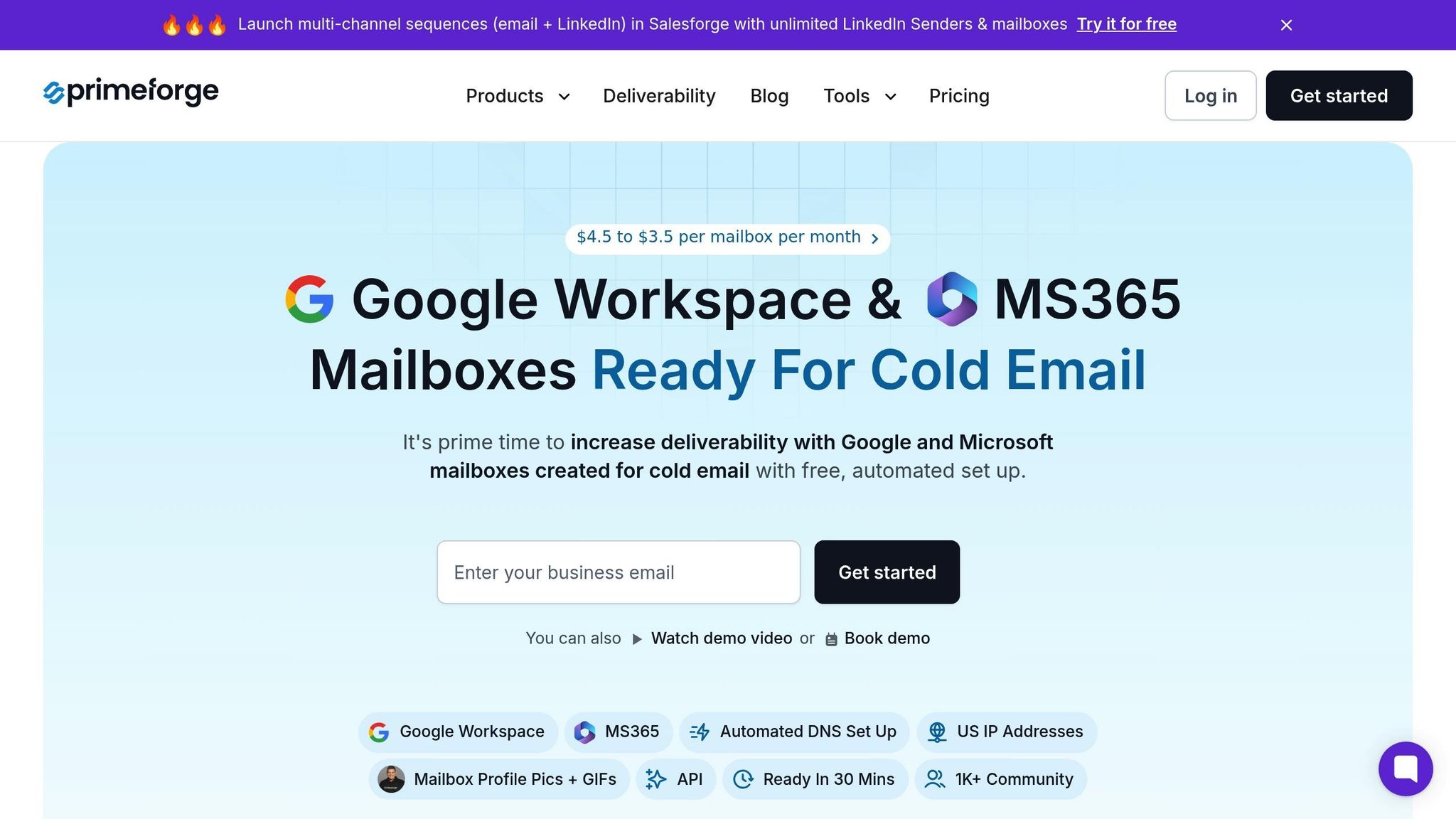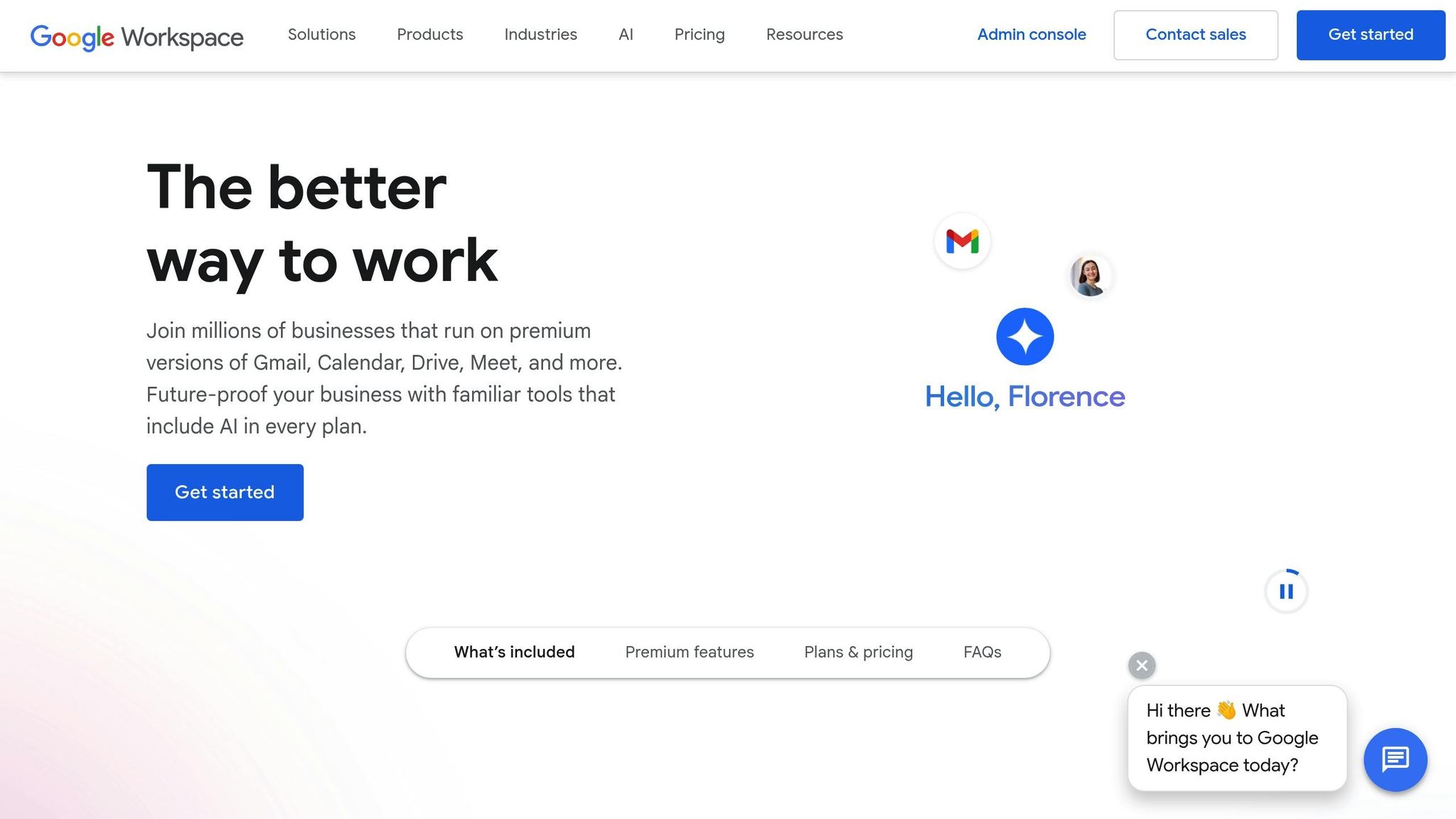The Power of Diversification: Why AI SDRs Need Multi-ESP Email Infrastructure
AI-powered sales development representatives (SDRs) are revolutionizing email outreach, but relying on a single email service provider (ESP) can jeopardize your campaigns. Issues like email throttling, blacklisting, or sudden policy changes can derail operations. The solution? A multi-ESP infrastructure.
Here’s why it works:
- Reduces Risk: Spreads email volume across multiple providers, minimizing disruptions from account issues or blacklisting.
- Improves Deliverability: Aligns ESPs with audience preferences, increasing inbox placement and engagement.
- Enables Scalability: Handles high email volumes by distributing workload across platforms.
Platforms like Primeforge simplify managing multiple ESPs by centralizing configurations, automating DNS setups, and ensuring compliance with email authentication standards (SPF, DKIM, DMARC). This approach ensures consistent performance, better deliverability, and uninterrupted outreach for AI SDR campaigns.
Why Multi-ESP Email Infrastructure Works
Modern AI SDRs face challenges that single-ESP setups often can't handle effectively. High email volumes, stricter filters, and shifting policies demand a more adaptable and resilient system. Relying on a single provider increases the chances of issues like throttling or blacklisting, which can disrupt entire campaigns. A multi-ESP setup addresses these challenges by creating multiple pathways for email outreach, minimizing risks and ensuring smoother operations. Let’s break down why this approach works so well.
Lower Risk with ESP Diversification
Using multiple ESPs spreads the risk across different platforms, reducing reliance on any single provider. If one ESP introduces new restrictions, encounters shared IP reputation problems, or faces account issues like spam complaints, your campaigns can continue running through other providers. This setup keeps your outreach efforts stable and minimizes disruptions.
Improved Deliverability with ESP Matching
Different ESPs have varying reputations depending on the audience segment they serve. A multi-ESP strategy allows you to align your sending infrastructure with your recipients' preferences, enhancing the chances of your emails landing in their inboxes. By matching the right ESP to the right audience, you can improve engagement and build trust more effectively.
Scaling for High-Volume Campaigns
Large-scale outreach often runs into daily sending limits and other safeguards imposed by providers. A multi-ESP approach solves this by spreading the workload across several accounts, keeping each within safe operating limits. This not only reduces the risk of spam flags but also allows you to warm up multiple accounts simultaneously. As your AI SDR campaigns grow, this strategy ensures you can scale efficiently without sacrificing deliverability or running afoul of provider policies.
How Primeforge Manages Multi-ESP Infrastructure

Primeforge is a platform designed to simplify the management of multiple email service providers (ESPs) for AI SDR campaigns. Instead of wrestling with separate accounts and configurations across various platforms, Primeforge centralizes everything into one streamlined system. This means teams can enjoy the advantages of using multiple ESPs without the hassle of managing them individually. From initial setup to ongoing operations, Primeforge takes care of the technical complexities, making multi-ESP infrastructure manageable even for teams with limited technical skills.
The platform can establish a fully functional multi-ESP infrastructure in just a few hours - far quicker than the weeks such setups typically take. This efficiency helps mitigate risks like service interruptions or performance issues, ensuring consistent outreach efforts.
Setting Up Google Workspace and Microsoft 365 Mailboxes

Primeforge offers pre-configured Google Workspace and Microsoft 365 mailboxes with US-based IPs and automated DNS settings. These configurations include essential protocols like DMARC, SPF, and DKIM, which are critical for email authentication. A bulk DNS update feature allows teams to configure multiple domains and mailboxes at once, saving time and reducing the chances of errors - especially when managing large-scale operations with dozens or even hundreds of mailboxes.
Each mailbox comes with professional-grade features, such as custom profiles and domain alignment, ensuring that emails sent to recipients appear credible and trustworthy.
ESP Matching Logic for Better Deliverability
Primeforge employs a smart ESP Matching logic that improves email deliverability by aligning the sender's infrastructure with the recipient's. For example, if a prospect uses Google Workspace or Microsoft 365, Primeforge routes emails through a corresponding mailbox from the same provider. This alignment increases the chances of emails landing in the recipient's primary inbox, as the systems are naturally compatible.
The platform achieves this by analyzing recipient domains and dynamically routing messages through the most appropriate Primeforge mailbox. This thoughtful approach enhances campaign performance by leveraging the deliverability advantages discussed earlier.
Automation and Scaling Features
Primeforge doesn't just simplify the initial setup - it also excels in ongoing management and scaling. The platform supports multiple workspaces, allowing teams to organize campaigns by client, product line, or region while maintaining centralized control.
It integrates seamlessly with existing outreach tools, including AI SDR platforms like Agent Frank from Salesforge, and offers mailbox export features for reputation management.
For high-volume campaigns, Primeforge uses multi-IP provisioning to distribute email traffic across multiple IP addresses. This prevents any single IP from being overwhelmed or flagged by ESPs for throttling. As campaign volumes grow, the system automatically scales to maintain optimal performance and deliverability.
Administrators also benefit from bulk management tools, which provide a clear, centralized view of all mailboxes and ESPs. This dashboard simplifies performance monitoring and ensures that the multi-ESP strategy continues to deliver results. These automation and scaling features make Primeforge a powerful solution for teams looking to maximize the benefits of a diversified ESP approach.
Best Practices for Multi-ESP Infrastructure
Managing a multi-ESP setup requires a thoughtful approach to ensure your email campaigns achieve high deliverability and stay resilient against potential risks. By refining your strategy with these best practices, you can sidestep common challenges and keep your AI SDR campaigns running smoothly.
Allocating Domains and Mailboxes
A key part of a strong multi-ESP strategy is how you allocate domains and mailboxes. To reduce risk, distribute your sending volume across multiple domains rather than relying on a single one. This way, even if one domain faces issues, your overall operations remain unaffected. Similarly, assign different ESPs to specific audience segments based on each platform’s strengths and capabilities.
When introducing new mailboxes or domains, take it slow. Start with a small number of emails to help establish a solid reputation with ESPs. Gradually increase the sending volume over time to avoid triggering spam filters.
Authentication and Compliance Setup
Uniform authentication across all ESPs is essential for maintaining a strong sender reputation. Ensure your SPF, DKIM, and DMARC records are properly configured from the outset. Using tools like Primeforge can make bulk DNS updates for these records more efficient.
For DMARC, start with a monitoring phase to gather data before enforcing stricter policies. Consistency in your authentication settings across ESPs is critical - it helps mail servers recognize your emails as legitimate, reducing the chances of delivery issues. Regularly review and update these records to catch and resolve any problems early.
Monitoring and Optimizing Performance
Continuous monitoring is crucial for a multi-ESP infrastructure. Keep an eye on key metrics like bounce rates and complaint rates at every level - ESP, domain, and individual mailbox. Set up automated alerts to flag any unusual trends so you can address issues promptly.
If certain domains or mailboxes consistently underperform despite proper setup and warming, it might be time to replace them. Regular performance reviews on platforms like Google Workspace and Microsoft 365 can offer valuable insights, helping you fine-tune your strategy and improve deliverability.
Finally, maintain detailed records of configuration changes and performance trends. This documentation not only aids in troubleshooting but also serves as a valuable resource as your operations grow.
Conclusion: Building Better Outreach with Multi-ESP Infrastructure
Relying on just one email service provider (ESP) is no longer enough to meet the demands of AI-powered sales development representative (SDR) campaigns. With rising email volumes and stricter compliance rules, multi-ESP infrastructure has become a must-have for maintaining strong deliverability and keeping outreach operations running smoothly. This approach unlocks the full potential of AI-driven outreach while safeguarding your efforts.
Using multiple ESPs reduces the risks of throttling, blacklisting, and reputation issues, ensuring your emails consistently reach their targets. By tailoring ESPs to specific audiences, you can improve both deliverability and engagement, aligning your outreach with recipient preferences for better results.
Primeforge tackles these challenges head-on with its multi-ESP solution designed for high-volume AI outreach. The platform simplifies multi-provider management with features like automated DNS setup, US-based IP addresses, and seamless integration with Google Workspace and Microsoft 365. All of this is done while adhering to compliance standards, making it easier to manage complex email operations.
Primeforge’s ESP matching logic, bulk DNS update capabilities, and tools for managing multiple workspaces empower AI SDRs to scale their outreach effectively without sacrificing deliverability. And with pricing set at $38 per month for 10 mailbox slots (billed annually), Primeforge offers a cost-effective way to move beyond the limitations of a single ESP, making diversified outreach more accessible for businesses of all sizes.
As AI-driven outreach continues to grow, companies that invest in a strong, diversified email infrastructure now will gain a competitive edge in the future. Multi-ESP infrastructure isn’t just a smart move - it’s essential for sustainable growth. With Primeforge, businesses can build a reliable foundation for their outreach strategies, setting themselves up for long-term success.
FAQs
What are the risks of using just one email service provider (ESP) for AI SDR campaigns?
Relying on just one email service provider (ESP) for your AI SDR email campaigns can be risky. If the provider notices a high volume of activity, they might take actions like throttling, flagging, or even blacklisting your account. These measures can seriously harm your email deliverability and outreach efforts.
Beyond that, sticking to a single ESP limits your ability to adjust to different audiences or bounce back quickly if problems occur. By spreading your campaigns across multiple ESPs and domains, you can reduce these risks, maintain consistent performance, and avoid potential disruptions.
How does Primeforge make managing multi-ESP email systems easier for AI SDRs?
Primeforge simplifies the challenge of handling multi-ESP email systems by offering seamless access to both Google Workspace and Microsoft 365 mailboxes. To boost deliverability and meet compliance standards, it ensures emails are sent through U.S.-based IP addresses. Plus, it takes care of the often tricky DNS setup automatically, cutting down on technical headaches.
What really sets it apart is its smart ESP matching feature, which aligns your outreach domains with the most effective platforms for reaching your audience. By spreading email activity across multiple ESPs, Primeforge reduces risks like throttling, flagging, or blacklisting. This means your AI SDRs can operate smoothly, ensuring consistent and dependable outreach.
What are the best practices for building and managing a multi-ESP email strategy to maximize deliverability?
To get the most out of a multi-ESP strategy and boost your email deliverability, start by setting up SPF, DKIM, and DMARC protocols. These authentication steps are key to building trust with email providers and ensuring your messages make it to inboxes.
Keep your sender reputation intact by focusing on engaging, relevant content and routinely cleaning up your email lists. Removing inactive or unengaged contacts can make a big difference in how email providers view your activity.
Pay close attention to performance metrics like open rates, click-through rates, and bounce rates. These numbers can quickly highlight any problems, giving you the chance to fix them before they escalate. Want another tip? Use subdomains to separate different email streams. This not only keeps things organized but also protects your main domain's reputation.
Finally, diversify your ESPs based on your audience. For example, Outlook might be a great fit for corporate outreach, while Google Workspace could work better for startups. This approach helps avoid issues like throttling or blacklisting and can even improve engagement with your emails.